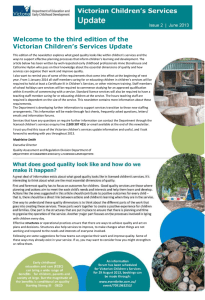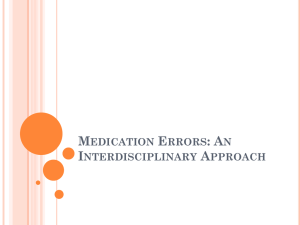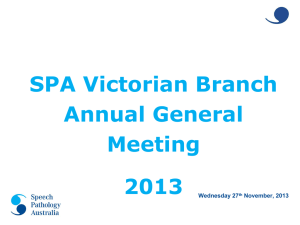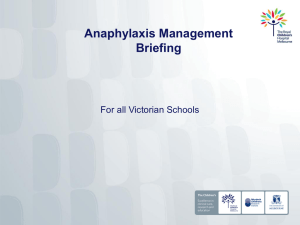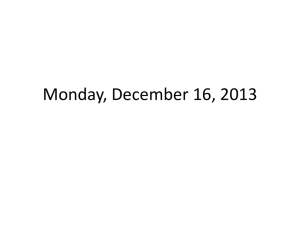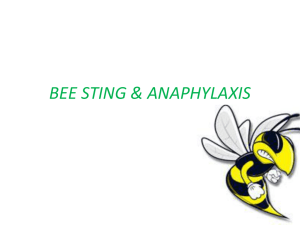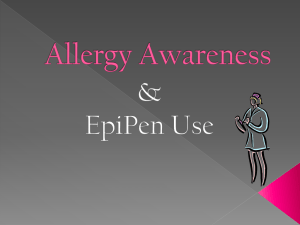29 August 2013 - Department of Education and Early Childhood
advertisement
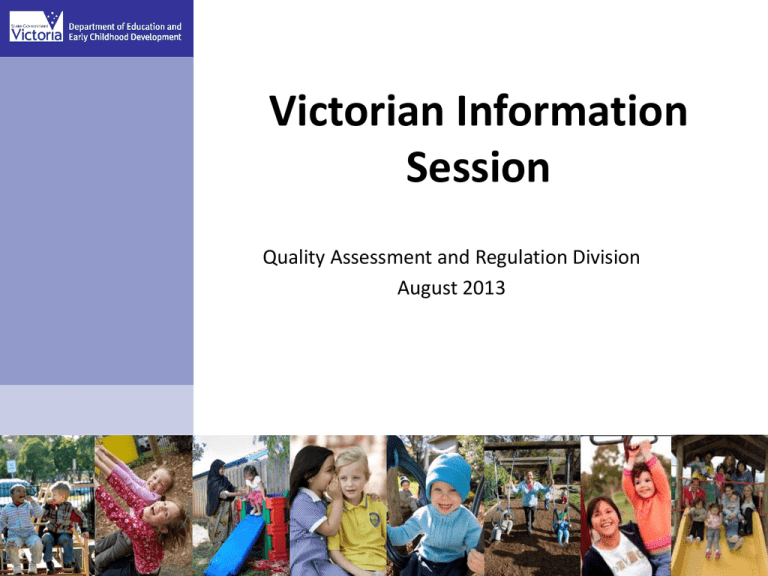
Victorian Information Session Quality Assessment and Regulation Division August 2013 Transitional Provisions 2014 On 1 January 2014, a number of transitional provisions in the Children’s Services Regulations 2009 will come into effect for children’s services. These changes apply to: • Minimum training requirements for staff members educating and caring for children • Teaching staff members (standard services only) Definition of staff member In relation to a children’s service, staff member means: • A person who is employed or has been appointed or engaged to be responsible for the care or education of children at the children’s service • Note a staff member who is aged under 18 years must be under the direct supervision of a qualified staff member who is aged 18 years or over (regulation 5). Definition of volunteers A volunteer, in relation to a children’s service, means a person who cares for or educates children at the children’s service in a voluntary or honorary capacity, and includes a student or a person on work experience (regulation 5). Short term or limited hours For short term or limited hours services no more than half of the individuals counted in the staff to child ratios may be volunteers (these volunteers must be over 18 years of age). Volunteers may not be counted in the minimum number on staff members on duty (regulation 50). Minimum Training Requirements Standard, limited hours and short term services From 1 January 2014, each staff member caring for or educating children at a service must meet one of the following requirements (regulation 130): • hold a Certificate III in Children’s services • hold a qualification or has training the secretary is satisfied is substantially equivalent or superior to Certificate III in Children’s Services • hold a qualification included in the list of approved Certificate III level education and care qualifications published under the Education and Care Services National Regulations 2011 (National Regulations) • Be a qualified staff member or a teaching staff member • hold a primary school teaching qualification • In the case of an early childhood intervention staff member, hold a qualification in a field the Secretary is satisfied is substantially equivalent (regulation 60) Staff to child ratios Limited hours type 1 service A limited hours type 1 service is a service where each child is cared for or educated for not more than two hours a day and not more than a total of six hours a week. • for children under three years a child/staff ratio of one staff member or volunteer for every five children or fraction of that number • for children three years or more, a child/staff ratio of one staff member or volunteer for every 15 children or fraction of that number (section 29A and regulation 55(1)) . Staff to child ratios Limited hours type 2 service A limited hours type 2 service is a service where each child is cared for or educated for not more than five hours a day and not more than a total of 15 hours a week. • for children under three one staff member or volunteer for every five children or fraction of that number and one qualified staff member for every 15 children or fraction of that number; and • for children three years or more one staff member or volunteer for every 15 children or fraction of that number and one qualified staff member for every 30 children or fraction of that number (section 29A and regulation 55(2)) . Staff to child ratios Standard service A standard service is a children's service that may care for or educate children under three and children three and over, including school aged children. Places for school aged children can comprise up to 30 per cent of the total number of places. • for children under three • 1 staff member for every 4 children or fraction of that number; and • 1 qualified staff member for every 12 children or fraction of that number; and • for children are aged three years or more • 1 staff member for every 15 children or fraction of that number; and • 1 qualified staff member for every 30 children or fraction of that number (regulation 53). Definition of Teaching Staff member A teaching staff member means a staff member who holds one of the following qualifications (regulation 5): • a qualification included in the list of approved early childhood teaching qualifications published under the National Regulations • an early childhood teaching qualification at degree level or above that has been approved by the Secretary and notice of this approval has been given in the Government Gazette. • An early childhood teaching qualification at degree level or above that the Secretary is satisfied is substantially equivalent or superior to a qualification which has previously been approved by the Secretary and published in the Government Gazette. Minimum hours of teaching staff educating and caring for children Educating and Caring for 25 or more children Educating and caring for fewer than 25 children A teaching staff member is caring for or educating children at the standard service or each standard service component for at least the lessor of the following: The service or each standard service component must have access to a teaching staff member working with the service if they are carrying out activities for the service, including caring for and educating children and planning programs, and they may be doing so by means of information communication technology. (regulation 52a (5(b)). • 50% of the time the service is open to care for or educate children; or • 20 hours per week (regulation 52(1)). Educator Qualifications Recognised minimum training and qualifications are published at www.education.vic.gov.au/childhood/providers/regulation /Pages/vcstrainingquals.aspx Also recognised are the qualifications published by the Australian Children’s Education and Care Authority (ACECQA). The approved educator qualification lists are: • Early childhood teaching qualifications • Diploma qualifications • Certificate III qualifications These lists are available at www.acecqa.gov.au Savings provisions for minimum training The requirement to hold an approved certificate III level qualification does not apply to staff members who have completed professional development in lieu of minimum training (regulations 364 and 366). These staff members were: employed in a licensed children’s service, outside school hours care service or family day care service on 25 May 2009; and employed in a licensed children’s service, outside school hours service or family day care service continuously for at least five years full-time or ten years part-time in the years immediately prior to 25 May 2009; and completed an approved professional development course by 1 January 2012. Exemptions If a service cannot meet a requirement of the Victorian Regulations the approved provider may apply for an exemption from the requirement. Exemptions are generally considered where the licensee can demonstrate genuine difficulty in meeting the relevant requirements. All possible ways to meet the requirements should be explored prior to making an application. Applications are considered by the Department with respect to all relevant circumstances of the service. Enquiries may be directed to csrr@edumail.vic.gov.au. Sometimes the Minister will grant an exemption from a requirement for a group of Victorian children’s services. Maintaining compliance with the Victorian Children’s Services Legislation Assessment Notices A licensee, primary nominee or nominee currently present and in charge or a children’s service must: • read a person’s current working with children assessment notice, or • in the case of a registered teacher, check the Victorian Institute of Teaching (VIT) register Before that person becomes an employee or is otherwise engaged as a staff member of a children’s service (regulation 70) Staff Records A children’s service must ensure that each staff member has a staff record (regulation 38). The staff record for staff members must include: • their name, address and date of birth • a copy of any relevant qualifications or certificates of completed training • their working hours • details of training in the administration of an adrenaline autoinjection device and cardio-pulmonary resuscitation • Details of training in first aid and anaphylaxis management • the date on which the current working with children assessment notice (or VIT registration) was considered by the licensee, primary nominee or nominee currently present and in charge of the service. Child Enrolment Records The enrolment record for each child must include: • The child’s name, address and date of birth • Name of each parent or guardian with whom the child resides with and details of other guardians if applicable • details of person to be notified of any incident, trauma or illness involving the child • details of any court orders related to a child or access to them • Details of persons with lawful authority to take the child outside the premises. • Details of any person who has lawful authority to consent to the medical treatment of the child. • The language used in the child’s home • The relevant authorisations set out in regulation 33, and the • The relevant health information set out in regulation 34, such as special needs of the child or other allergies. Medication Records The medication record for each child must include: • • • • • The child’s name The authorisation to administer medication The name of medication to be administered The time and date the medication was last administered The time, date and circumstances in which medication should next be administered. • The dosage of medication to be administered. • If medication is administered to the child: - the dosage that was administered - the time and date the medication was administered - the name and signature of person who administered the medication - the name and signature of the person who checked the dosage administered inline with regulation 83. Accident, injury, trauma and Illness record The accident, injury, trauma and illness record must include: • Details of any accident, injury or trauma to which a child is subject to while being cared for by the children’s service • Details of any illness which becomes apparent while the child is being cared for or educated by the children’s service • Details of the action taken by the children’s service in relation to any accident, injury or trauma or illness which a child has suffered • The name of who was notified of the accident, injury, trauma or illness • The name of the signature of the person making an entry in the record, and • That this information is recorded as soon as practicable, but not later than 24 hours after the accident, injury, trauma or onset of the illness. Anaphylaxis Management Policy A children’s service must ensure that the service has in place an anaphylaxis management policy that includes: • the procedures for training of staff • the practices and procedures to ensure compliance with the children’s service regulations • that a risk minimisation plan has been developed for each child diagnosed at risk of anaphylaxis accessing the service • that an anaphylaxis medical management plan has been obtained from the parent or guardian of a child diagnosed at risk of anaphylaxis • in the instance that a child has an anaphylactic episode, that the medical management plan must be followed. • that the risk minimisation plan contains at a minimum matters contained in clause 3, (p166, Children’s Services Regulations) • a communication plan contains at a minimum matters contained in clause 4, (p167, Children’s Services Regulations 2009) Practice Note 3: Anaphylaxis Management Information to be displayed A children’s service must ensure the following information is displayed prominently at the main entrance to the premises: • • • • • • • • • • the hours and days of operation The name of licensee, body corporate, representative or provider The names of all nominees, identifying the primary nominee An outline of the recreational or educational program Fees charged by the service Details of emergency evacuation procedures Details of person to whom complaints can be referred to Contact details of the responsible office of the Department A list of information available for inspection under regulation 41 Notice of children attending the service that have been diagnosed as at risk of anaphylaxis DEECD website www.education.vic.gov.au/childhood/providers/regulation Resources for Victorian children’s services Information for Victorian children’s services is available on the Department’s website: www.education.vic.gov.au/childhood/providers/regulation - Fact sheets, including: - Assessment or Fit and proper person Qualified staff member lunch break Staff members and staff requirements Volunteers in licensed children’s services Frequently asked questions Newsletters Guides Practice Notes Follow the Department on Twitter @DEECD. Regulatory Authority in Victoria Department of Education and Early Childhood Development Quality Assessment and Regulation Division Ph. 1300 307 415 licensed.childrens.services@edumail.vic.gov.au www.education.vic.gov.au/childhood/providers/regulation @DEECD
